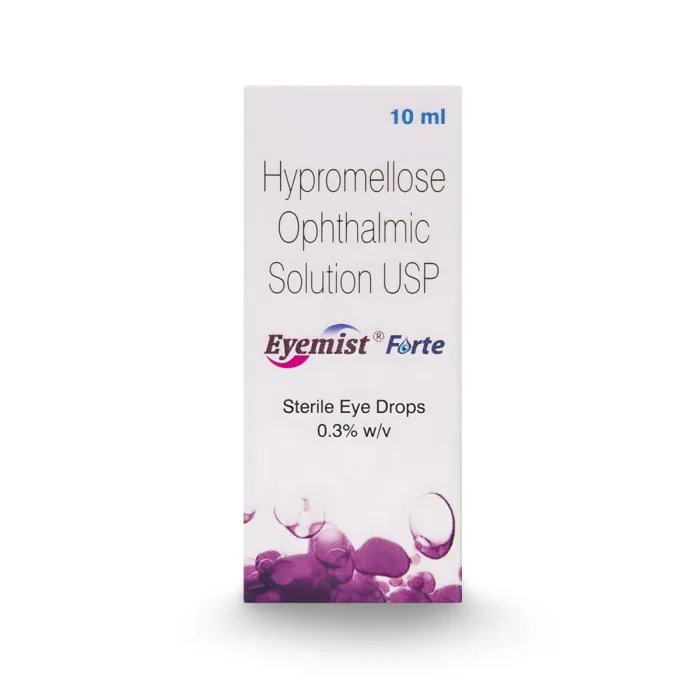Fungal Keratitis is a serious and potentially vision-threatening eye infection.
It is a condition caused by various types of fungi invading the cornea.
Prompt diagnosis and treatment are essential to prevent vision loss and manage the often painful symptoms associated with Fungal Keratitis.
This article will explain what is Fungal Keratitis, Fungal Keratitis’s early symptoms and its treatment.
What is Fungal Keratitis
Fungal Keratitis is a fungal infection that affects the cornea, the transparent front part of the eye.
This condition primarily affects individuals who have eye injuries, wear contact lenses, or live in humid conditions.
Fungal Keratitis is initiated by various species of fungi, including Furasium, Aspergillus, and Canadida.
Fungal Keratitis frequently affects individuals with agricultural or outdoor occupational exposures.
Save up to 90% on your medicine bills

Eyemist Forte 10 ml

Milflox 0.5% 5 ml

Restasis 0.05% Ophthalmic Emulsion

Pred Forte 10 ml
Fungal Keratitis vs Bacterial Keratitis
To understand Fungal Keratitis, it is important to distinguish it from its bacterial counterpart.
As the name suggests, Bacterial Keratitis is caused by bacteria, such as Staphylococcus aureus or Pseudomonas aeruginosa.
Bacterial Keratitis often occurs in individuals with a history of contact lens use, corneal trauma, or compromised immune systems.
Fungal Keratitis Symptoms
 Source: Alona_Sinhea
Source: Alona_SinheaFungal Keratitis typically starts subtly, making it important to recognize the early signs and seek prompt medical attention.
The initial symptoms are similar to those of Bacterial Keratitis, including eye redness, decreased vision, light sensitivity, and excessive tearing.
Eye redness and eye pain: Red eyes and eye pain are common signs of Fungal Keratitis. It is often accompanied by pain or discomfort, prompting individuals to seek medical care.
Decreased vision: Blurred or decreased vision in the affected eye is another common early symptom. This is often progressive, worsening as the infection advances.
Light sensitivity: Photophobia, or heightened sensitivity to light, is frequently associated with Fungal Keratitis. Patients may find it painful to be in a well-lit environment.
Excessive tearing: Excessive tearing and discharge from the eye can occur. This discharge may be clear or have a characteristic appearance, which could be crucial in diagnosing Fungal Keratitis.
These symptoms are not specific to Fungal Keratitis, so these symptoms can be easily confused with symptoms of other types of keratitis or other eye infections.
To learn more about Keratitis symptoms, read Keratitis Symptoms: Recognizing the Signs of Corneal Inflammation.
Fungal Keratitis Treatment
 Source: Devonyu
Source: DevonyuFungal Keratitis can be challenging to treat, but it is often possible to resolve the infection and minimize its impact on vision with appropriate management.
The choice of treatment depends on the severity of the infection and the specific type of fungus involved.
Let’s talk about the available treatment options in detail.
Antifungal eye drops: Antifungal eye drops are the first go-to medicine for Fungal Keratitis treatment.
These Fungal Keratitis eye drops are typically prescribed and used frequently throughout the day and night.
The choice of antifungal agent may vary depending on the fungal species responsible for the infection.
To learn more about other eye drops for Keratitis treatment, read Here’s All You Need to Know About Keratitis Eye Drops.
Oral antifungal medications: In more severe cases or when the infection is unresponsive to topical therapy, oral antifungal medications may be added to the treatment regimen.
These medications are taken by mouth and are generally reserved for systemic infections that have spread beyond the cornea.
Debridement: In some cases, your opthalmologist may perform debridement, which involves removing the infected corneal tissue to help the eye heal.
This can be an essential step in severe infections.
Corneal transplant: When the cornea is extensively damaged, and vision cannot be restored with medical treatment alone, a corneal transplant may be necessary.
The damaged cornea is replaced with a healthy donor cornea during this procedure.
To learn more about treatment options available for Keratitis, read A Complete Guide to Keratitis Treatment and Prevention.
Conclusion
Fungal Keratitis is a less common but potentially vision-threatening eye infection that can occur in individuals of all ages.
While it shares some symptoms with other eye conditions, early diagnosis and proper treatment are crucial to minimize the impact on vision.
If you experience persistent redness, decreased vision, light sensitivity, or excessive tearing, do not hesitate to seek medical attention.
Fungal Keratitis, like any other health condition, is best managed when detected and treated in its early stages.

Frequently Asked Questions
How long does Fungal Keratitis take to develop?
The time it takes for Fungal KEratitis to develop can vary from person to person. In most cases, the symptoms may appear within a few days to a couple of weeks after the initial fungal exposure or injury.
See our Recommendations
How long does Fungal Keratitis last?
The duration of Fungal Keratitis depends on several factors, including the severity of the infection, the type of fungus involved, and how early it is diagnosed and treated. Mild cases may resolve in a few weeks with appropriate antifungal therapy, while more severe cases can extend for weeks.
See our Recommendations
What are the most common risk factors for Fungal Keratitis?
The most common risk factor for Fungal Keratitis is occupational or recreational exposure to organic materials like soil, plant matter, and dust.
See our Recommendations
Is Fungal Keratitis painful?
Yes, Fungal Keratitis can be painful. Patients often report symptoms such as eye redness, sensitivity to light (photophobia), and decreased vision, all of which can cause discomfort and pain.
See our Recommendations
Can Fungal Keratitis be cured?
Yes, Fungal Keratitis can be effectively treated and cured with prompt and appropriate medical intervention. The key is early diagnosis and initiation of antifungal therapy.
See our Recommendations
Cheap Medicine Shop only refers to credible, authoritative sources for our content. If you’re curious about how we ensure the integrity of our content, we encourage you to read our Content Information Policy.












